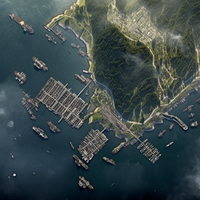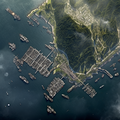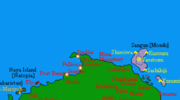Corsair Wars
| Corsair Wars | |||||||
|---|---|---|---|---|---|---|---|
| Part of Wars of the Disinherited | |||||||
 Corsair fleets gathering on the northwest coast of Corum |
|||||||
|
|||||||
| Combatants | |||||||
| Commanders and leaders | |||||||
| Various National and Continental Commanders | |||||||
| Units involved | |||||||
| Various National and Pact Fleets, including: |
|
||||||
| Significant intelligence failures by Raspur Pact intelligence agencies led to a lack of awareness of the growing threat. | |||||||
The Corsair Wars (1718 AN – ) were an emergent aspect of the Wars of the Disinherited, which saw the Confederacy of the Dispossessed begin to harness the endemic piracy which had taken root in the Sea of Storms following the collapse of the Bassarid Empire, and turned it into an escalating campaign of commerce raiding directed against the trade fleets of the Raspur Pact in the Sea of Storms, the Captive Sea, and finally amongst the Skerry Isles, where the actions of the corsair fleets began to take on the semblance of a nautical insurgency against the land power of the Pact.
The Confederacy of the Dispossessed had seemingly been able to secure, by late 1719 AN, the balance of maritime assets previously held by the Bassarid-aligned Leagues of Corumia, less those of the Wallis Island Division which had instead passed into the hands of an entity calling itself the Southern Peoples' United Autonomous Government.
Background
Allied strategic responses to the Corsair threat
The Sea of Storms is divided between areas of responsibility allocated to Keltia Command north of latitude (tbc), whilst Trans-Euran Command has responsibility for the remainder. Amongst the members of the Raspur Pact, Nouvelle Alexandrie is notable for having major territorial holdings within the areas of operation for both continental theatre commands. However, it should be noted that the primary focus of New Alexandrian maritime strategy in the Trans-Euran Theatre has hitherto been concerned with the defence of the maritime sphere of Alduria, dominating the north and west coasts of Eura, and the linkages between Aldurian ports with Natopian Tapfer to the west, and the Alexandrian holdings on Lyrica to the north and the Skerry Isles to the north east, which provide the stepping stones linking Alduria with the Wechua Nation, its Keltian co-founder of the Federation to which both belong. The naval priorities of Nouvelle Alexandrie within the Keltian continental theatre revolve around the defence of its expansive coastline along the southern shores of Keltia, which encompass the Skerry Isles, the Captive Sea, and the Sea of Storms.
What both continental theatre commands, and the national governments of the Pact member states in the regions have to be mindful of the transit of the trade fleets, the primary mechanism by which intercontinental trade is carried on between the member economies of the Pact's member states. Whilst it had been a long time since Bassarid pirates had attempted to attack a trade fleet whilst in convoy, the collapse of the Bassarid Empire and the rise of the Confederacy of the Dispossessed, the corsair captains were now, motivated by greed and a desire for revenge of the loss of Passas, minded to try their hand at a singular and extravagant form of revenge.
Keltia Command
Trans-Euran Command
Constancia
Nouvelle Alexandrie
At the direction of the Department of Defense, the Pontecorvo Firm and ESB Susa were instructed to halt all ongoing work in order to refocus upon immediate naval requirements under an Emergency Shipbuilding Program.
The initial order was for sixty Manco Cápac-class cruisers to be built, with the work to be divided equally between Pontecorvo and the Honourable Company shipyards in Nouvelle Alexandrie, with these to be launched by the end of the year, with the fitting out of armaments, sensors, and command and control systems to be conducted by Javelin Industries and partners, utilising off-the-shelf systems available for use. Only existing technologies were to be utilised, with R&D work actively prohibited with regards to the program.
Commissariat agents from the National Ordnance and Procurement Board were duly dispatched, during the fourth month of 1719 AN, to establish a Department of Defense presence at the following shipyards:
- Pontecorvo Shipbuilding Yards (Pontecorvo, Alduria)
- Rothborne Shipbuilding & Offshore Industries Complex (Rothborne City, Alduria)
- La Fortaleza de Melusina Yard Complex (La Fortaleza de Melusina, South Lyrica).
- Port Tablot Shipyards (Port Tablot, Isles of Caputia)
- Aldurian Shipbuilding Yards (Alkhiva, Alduria)
- ESB Armada (Alkhiva, Alduria)
Accordingly, each yard faced the obligation to lay down and launch ten hulls within the space of a year. It was a task that was met with a certain level of scepticism in the industry as details first began to be made known. These doubts began in turn to be noted by the various trade press publications. This had the inevitable result that speculation began to appear in left and liberal leaning national news coverage as to the feasibility of the programme, and moreover what sorts of trade offs would be required in order to achieve the requisite number of hulls laid down within the stipulated time.
The depth of the scandal was only realised when, during VII.1720 AN, word leaked out that, instead of sixty vessels being laid down, work had only commenced upon two, and even these were not yet launched. Moreover, as these ships took shape, it became obvious to all observers that the "cruiser" shared obvious commonalities with the Andronikos-class auxiliary cruiser of the Constancian Navy, which in turn had been built off the pattern set by the SS Andronikos, a decrepit and ancient Babkhan merchantman, now gently rusting at anchor in the fetid port of Tiegang. Some naval analysts however maintained that the troubled ships would eventually reveal themselves to be up-armed and up-armoured iterations of the Logistic Support Vessel, a design now sixty-five years old.
Ironically, a part of the delay in the shipbuilding programme had been occasioned by jurisdictional conflicts between the National Ordnance and Procurement Board under the Department of Defense and the Joint Production Accelerator Cell within the Office of Procurement, which reported directly to the Office of the President. Both entities in turn reacted against attempts by the Naval Forces Office and Military-Industrial Relations Bureau of Keltia Command to reorientate New Alexandrian shipbuilding towards launching escort corvettes capable of escorting transoceanic trade fleets, whilst fending off the continuous entreaties of Trans-Euran Command for a focus instead upon landing craft and minesweepers capable of operating within the Gulf of Zinjibar.
Dilemma facing the corsair fleets
Although the twelve Corsair fleets enjoyed an early initiative in reaving the shipping lanes of the Sea of Storms at will, they were severely hampered by the steady reduction in the number of safe anchorages that were available to them. The Raspur Pact conducted a series of kinetic orbital strikes against the former Bassarid ports which might serve as logistical bases for the fleets. First Pallisica, Port Brent, and Sincláir, and then Rei were knocked out of operation. These actions, combined with the occupation of Passas by Nouvelle Alexandrie, meant that the corsairs were faced with the choice to either disperse, increasing the likelihood that they would be hunted down and dispatched piecemeal, or else to find shelter on the coast of Norasht in Eura. If they chose the latter option they would, in addition to the orbital threat, run the risk of coming under sustained aerial assault by land-based aviation.
Timeline
- XV.1719–V.1720: Vessels belonging to the eighth, ninth, and twelfth corsair fleets, which included a mixture of ex-Bassarid naval vessels and captured merchant shipping, gathered at the ports of Pallisica, Port Brent, and Sincláir on the northwest coast of Corum over a period of six months. In spite of the increase of Natopian and New Alexandrian surveillance satellites placed into orbit over the past decade, the steady build-up of shipping at ports in northern Corum passed unremarked. This failure would subsequently be attributed to the failure of the various continental theatre and national commands to establish combined-joint intelligence fusion centres capable of interpreting data collated from satellite imaging and SIGINT sources.
- 7.VI.1720: The corsair fleets had hoped to remain in their safe harbours for another month, as vessels were equipped with suitable armaments, provisions and fuel were taken onboard, and new crew members, both recruited and impressed, were put through their paces. Yet now, it was discovered that word of their armada had gotten out and received wide coverage on the news networks of Nouvelle Alexandrie. Whatever comfort could be taken from the months of grace accorded by intelligence failures in the Raspur Pact, it was imperative for every available craft to put to sea and set forth. Within days, the majority of the assembled vessels had begun to be put to sea. Their ultimate destination being an unknown one, but a source of trepidation in capitals across two continents.
- 9.VI.1720: Units of the Natopian Spacefleet launch kinetic orbital strikes on the ports of Pallisica, Port Brent, and Sincláir on the northwest coast of Corum. The strike on Pallisica proves highly successful, with most of the intended targets being hit, causing considerable damage to the port. Numerous facilities and ships are heavily damaged or destroyed, severely affecting the port's operations. Among the casualties is the shipyard's main dry dock and several cargo storage facilities, crippling the port's logistical capabilities. However, the strikes on Port Brent and Sincláir fare less successfully. In Port Brent, a minor calibration error in the targeting system causes the kinetic rods to splash down in the ocean, missing the port entirely and causing only minimal damage to peripheral facilities. Similarly, in Sincláir, atmospheric interference affects the trajectory of the rods, causing them to strike a largely uninhabited area away from the port. As a result, no significant facilities or ships are damaged in either Port Brent or Sincláir, leaving their operations largely unaffected. While the strike on Pallisica marks a significant victory for the Natopian Spacefleet, the failure to significantly damage Port Brent and Sincláir underscores the challenges of orbital strike warfare and highlights the need for further improvements in strike accuracy and reliability.
- This strike represented the first occasion on which all three Damocles-class orbital bombardment platforms had been employed in a single coordinated strike. The deficiencies of attack are liable to be the subject of further study and reflection by the NDF.
- 23.VI.1720: The Imperial Sangunese Navy and their Wallisian allies engaged a large corsair fleet in the Straits of Sangun, after the latter frustrated attempts to resupply Sangunese land forces operating in northern Corum: three corsair vessels were destroyed, but a Wallisian Bijeko-class attack vessel was sunk and three Indigo-class gunboats, together with a Sangunese battleship and cruiser, were damaged. With only sixty percent of their ships fit for service, the allied fleet was compelled to return to port, effectively surrendering control of the straits to the corsairs.
- 12.VII.1720: A squadron of the New Alexandrian Federal Navy, operating in the Sea of Storms, encountered a small flotilla of vessels identified as belonging to the Confederacy of the Dispossessed. In what was later hailed as a textbook execution of anti-piracy tactics, the Federal Navy managed to successfully corner and disable the pirate ships, capturing their crews with minimal casualties. The squadron, led by the frigate HRMS Resolute, managed to capture three pirate vessels, including one Bijeko Class Attack Craft that was serving as the pirates' main command ship. This operation represented a significant victory for the New Alexandrian Federal Navy, boosting morale among the naval personnel and sending a clear message of deterrence to the pirate factions operating in the region.
- 14.VII.1720: Action of 14.VII.1720 – elements of the eighth, ninth, and twelfth corsair fleets engaged the SATCo trade fleet bound from Nivardom to San Francisco.
- 16.VII.1720: The Natopian Spacefleet set its sights on the former Bassarid port of Rei in Eura, their target: the decimated First Fleet hiding in the shadows. The First Fleet was originally based in Passas but was severely damaged by Operation Purple Splendor. It was returning from the high seas where it impressed hundreds of escaping Pallisicans into forced service in its ranks. The strike was partially successful. They had managed to inflict moderate damage to the First Fleet. The initial assessment indicated that between 25% and 50% of the fleet was damaged or destroyed. The Natopian Spacefleet would regroup, analyze, and learn from this operation too.
Gallery
- The Corsair Wars
Satellite view of Corsair fleets gathering on the northwest coast of Corum.
Maps of the locations of the 9.VI.1720 orbital strikes by the Natopian Spacefleet.


